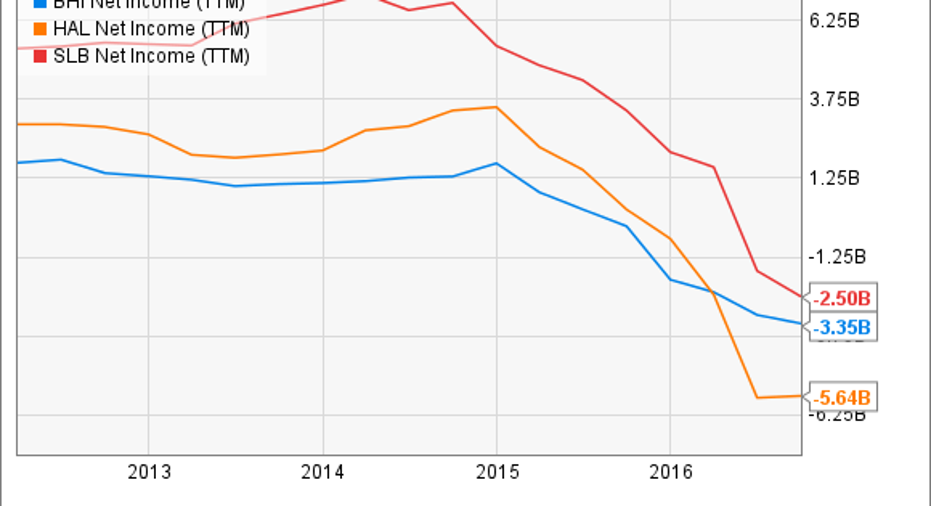What Does 2017 Hold for Oil Prices?

2016 saw a sharp rise in oil prices, bouncing off of lows that would have proved unsustainable for more oil companies long term. Brent crude's spot price rose a whopping 50.1% last year, and WTI crude oil was up 44.8%.
Despite last year's rise, there are some signs that 2017 could be an even better year for oil prices. Maybe the absolute gain in oil won't be as large, but we could see prices move higher -- and see a return of a U.S. shale industry that's been awfully quiet for a few years now. Here's what to watch for in oil prices.
Image source: Getty Images.
Will OPEC hold together?
The most notable change of the last few months is OPEC returning to its role as the controller of oil prices in 2017. The oil cartel teamed up with Russia and Oman to cut 1.8 million barrels per day of oil production, which is aimed at pushing oil prices even higher than they are today. So far, cuts have been steeper than expected, with Saudi Arabia, Algeria, and Kuwait all cutting production more quickly than expected, indicating that there's real traction in the cuts.
What'll be worth keeping an eye on this year is how OPEC holds together. Countries often exceed their production quotas as they try to squeeze a little more money out of oil markets, but OPEC will try to keep its members in line for the good of everyone. If they succeed, another 50% rise in oil prices, to $75 to $80 per barrel, wouldn't be out of the question.
Shale oil will play a big roll in oil prices
One region that isn't subject to the production quota is the U.S. Oil producers here are driven more by market forces than anything else, and they're already starting to respond to the rising price of oil.
According to Baker Hughes' (NYSE: BHI) weekly rig count data, oil explorers are indeed starting to drill again. You can see that drilling activity has nearly doubled from its low in the middle of last year, and that means U.S. oil production could stop its recent decline.
US Rig Count data by YCharts.
If oil prices continue to rise, rig activity will pick up as well. That's good news for rig owners and fracking service companies like Halliburton (NYSE: HAL) and Schlumberger (NYSE: SLB), who have been absolutely crushed financially in the last two years.
BHI Net Income (TTM) data by YCharts.
But this excitement about increasing oil prices leading to more drilling will actually dampen the supply reductions OPEC is making. If too much U.S. oil comes online, like it did between 2005 and 2014, it could lead to oversupply and act as a cap to how high prices can go.
Investors will want to watch where U.S. oil production trends. If it starts to rise because oil prices are going up, then OPEC may respond with more production, in turn pushing oil prices lower and hurting shale companies again. It's really U.S. supply that could keep a cap on oil prices in 2017.
Don't forget about the dollar
One factor in oil prices that often goes overlooked is the dollar's impact. A rising dollar means more buying power for U.S. consumers of oil, which means if oil prices are flat in dollar terms, but the dollar gets stronger, then exporting countries see oil prices rising in their local currencies. But a falling dollar has the opposite effect, making each dollar spent to buy oil overseas worth less to other countries.
If the government moves toward a weaker dollar policy, it would have the effect of making oil more expensive in dollar terms. That could be good for U.S. oil producers, although it would be bad for consumers.
The problem is that we don't know where the dollar is headed, and the currency market can change course rapidly. With that said, the dollar is worth keeping an eye on in 2017.
Where oil prices are headed in 2017
If OPEC can hold together, which it looks like it will for now, I think the trend of rising oil prices will continue. But there will be a cap on how fast prices will rise because U.S. shale drillers are eager to begin drilling again. Barring any global events that disrupt oil markets, another 10% to 20% increase in oil prices in 2017 is certainly within reach. And that could help energy stocks recover some of their losses from the last three years.
10 stocks we like better thanWal-MartWhen investing geniuses David and TomGardner have a stock tip, it can pay to listen. After all, the newsletter theyhave run for over a decade, the Motley Fool Stock Advisor, has tripled the market.*
David and Tomjust revealed what they believe are the10 best stocksfor investors to buy right now...and Wal-Mart wasn't one of them! That's right -- theythink these 10 stocks are even better buys.
Click hereto learn about these picks!
*StockAdvisor returns as of December 12, 2016.The author(s) may have a position in any stocks mentioned.
Travis Hoium has no position in any stocks mentioned. The Motley Fool owns shares of Halliburton. The Motley Fool has a disclosure policy.